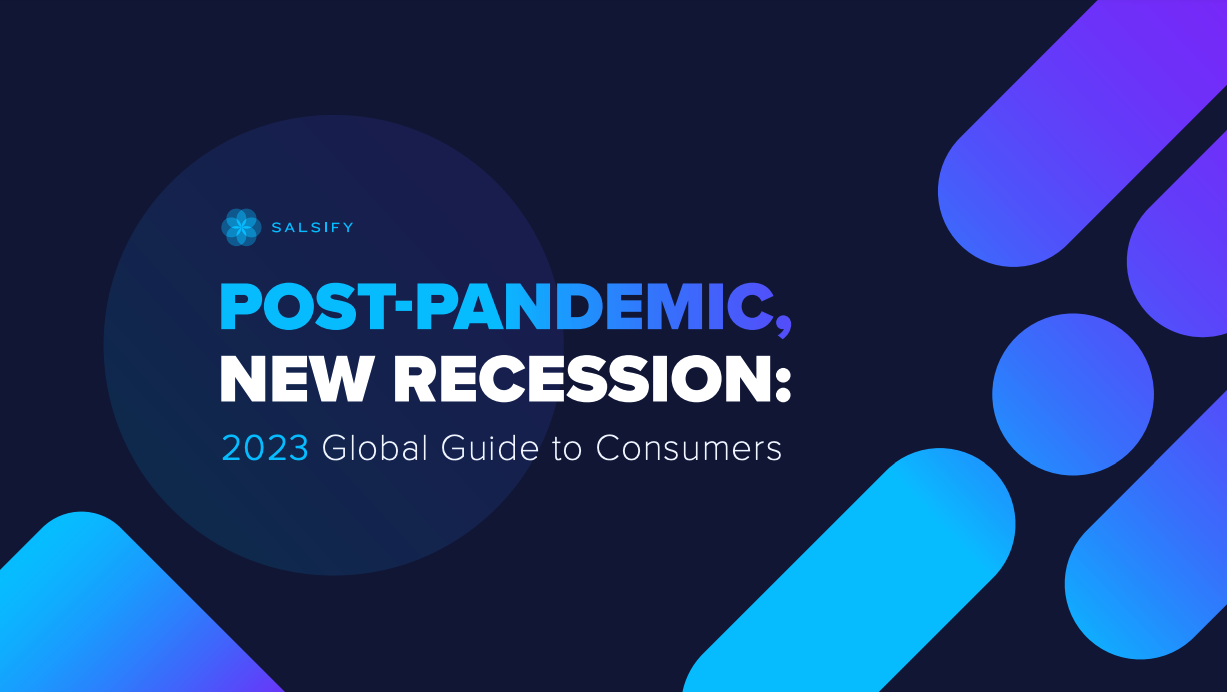

2023 Consumer Research Report
Interested in learning more about the changing consumer attitudes shaping the ecommerce landscape today? Download our report for expert insights into what makes today’s shoppers tick.
DOWNLOAD NOWPIM
Manage all product content in one central system of record.
Syndication
Easily syndicate product content to every consumer touch point.
Enhanced Content
Enrich product pages with below-the-fold content and rich media.
Intelligence Suite
Bring AI-powered capabilities directly into your Salsify workflows.
Grocery Accelerator
Leverage the first-ever category-wide PXM accelerator in the grocery industry.
GDSN Data Pool
Synchronize standard supply chain, marketing, and ecommerce attributes globally.
Digital Shelf Analytics
Continuously optimize your organization’s product content syndication.
Catalog Sites
Share secure, on-brand, and always up-to-date digital product catalogs.
Automation and AI
Automate business processes and enhance Salsify workflows with AI.
PXM Platform, Integrations, and APIs
Integrate the PXM platform with the rest of your enterprise systems architecture.
Supplier Onboarding
Accelerate supplier onboarding while ensuring your schema requirements are met.
Product Listing
Sell products faster with Product Listing.
Content Enrichment
Increase online conversions with Content Enrichment.
Automation
Save time and increase operational efficiency with retail automation.
SXM Platform, Integrations, and APIs
Integrate the SXM platform with the rest of your enterprise systems architecture.
Syndication Network
Automate how you exchange product content data to the digital shelf.
Enhanced Content Network
Turn product pages into product experiences with Enhanced Content.
Commerce Platform Integrations
Create winning product experiences everywhere shoppers are, including on owned sites.
GDSN Data Pool
Synchronize standard supply chain, marketing, and ecommerce attributes globally.
Open Catalog
Connect to the digital shelf faster with an open, standardized, and free product catalog.
Resources
Resource Library
Explore our ecommerce resources to get everything you need to win on the digital shelf.
Blog
Read our blog to get actionable insights for navigating changing markets and industry demands.
Webinars
Watch our on-demand ecommerce webinars to gain expert advice and tips from our community of industry leaders.
Customer Blog
Gain the latest tips, industry trends, and actionable ecommerce insights.
Knowledge Base
Investigate our knowledge base to build your Salsify skills and understanding.
API
Examine our comprehensive API and webhook guides to start working with Salsify quickly.

Download the report to get expert insights, consumer research, and top industry trends.

The internet and ecommerce have fundamentally changed how most people shop, and digital marketing for ecommerce continues to evolve.
Salsify found in its “2023 Consumer Research” report that 54% of global consumers changed their shopping habits compared to their pre-pandemic behavior.
Sixty-eight percent reported that they were shopping online more often than before.
This shift underscores the importance of retaining familiarity with digital marketing best practices, especially when it comes to creating a digital marketing strategy for ecommerce.
When selling products via digital channels, it makes sense to take advantage of digital techniques to raise awareness of your brand and, ultimately, drive sales.
Like traditional marketing, digital marketing in ecommerce is about more than just selling products online. It’s about curating, personalizing, and consistently providing a seamless journey for your customers, from awareness to purchase.
And as the customer journey increasingly takes place along the digital shelf, effective digital marketing strategies will make the difference between getting lost in the noise and standing out from the crowd.
These omnichannel campaigns — bridged across various digital platforms — play a crucial role in driving traffic to product pages and ecommerce portals. They can increase brand visibility in a crowded online marketplace, attract new customers, and even retain existing ones.
Here are five different types of digital marketing campaigns and what roles they might play in an effective digital marketing strategy.
These campaigns include mainstays like pay-per-click (PPC), display ads, and retargeting, empowering brands to promote their products throughout various digital platforms and (ideally) reach a larger audience.
Much like advertising in traditional channels, the power of this approach lies in its ability to target specific demographics — in other words, helping to ensure that your ads are seen by an audience with whom they’re most likely to be effective. This targeted approach allows brands to maximize their return on interest (ROI), and avoid wasting resources to show ads to shoppers who aren't as interested in their offerings.
By analyzing which elements work best (and which don’t), brands can gain and leverage some tremendous insights in their future campaigns. This continuous process of testing, learning, and optimizing is what makes paid advertising such a powerful tool for ecommerce businesses.
You could have some of the most effective ad copy, visual art, or pricing in the marketplace, but it won’t mean anything if your customers can’t find it when they need it.
This brings us to another critical component of digital marketing for ecommerce: search engine optimization (SEO).
SEO involves optimizing your touch points in order to rank higher in search engine results — whether on Google, Bing, Amazon, or other places customers search for products. Naturally, the higher your site ranks, the more visibility it will have with potential customers — increasing the likelihood of better sales.
Though similar, ecommerce SEO and traditional SEO differ slightly. For instance, while the latter focuses on improving the overall ranking of a website, ecommerce SEO’s focus concerns optimizing individual product pages throughout all of your channels.
Best practices might include approaches like using relevant keywords in product descriptions, ensuring high-quality product images, making your site mobile-friendly, and more.
Remember, every platform is different — make sure your product pages adhere to each channel’s best practices — like Amazon’s guide to A+ content — to increase your visibility.
Could your customers benefit from a regularly published newsletter? Updates about product availability or features? Or maybe you’d like to coax them back to purchase after they’ve abandoned their cart?
Email marketing is a powerful part of the marketer’s toolbox. It allows brands to directly engage their customers with personalized offers, updates, and reminders that, when done effectively, can drive both sales and customer retention.
Beyond those immediate goals, email marketing can also play a pivotal role in sharing your brand’s story, values, and mission — while ultimately fostering a deeper connection with your customers.
In addition, this approach can provide your team with valuable data and insights. By analyzing metrics like open rates, click-through rates (CTR), and conversion rates, brands can better understand what resonates with their audience, and broadly adapt these findings across their existing channels.
Facebook, TikTok, Instagram. We all know how ubiquitous and powerful these platforms have become over the past 15 years. But what are the implications and benefits for digital marketers?
Consider this: Salsify research also shows that social media has become the number one way customers discover new products online. Forty-two percent of customers said they've gone so far as to buy products directly from a social media channel.
There is tremendous potential to drive both product discovery and conversions on popular social channels. However, different social media platforms may be better suited for different approaches.
For example, with its visual focus, Instagram is an ideal channel for showcasing beautiful product and lifestyle photos related to your brand. A site like Twitter, on the other hand, is probably more suited for efforts like real-time customer service and quick responses.
As you can imagine, there are a few different effective strategies brands could take on this front. User-generated content (UGC), such as customer reviews or photos of customers using your products, can provide other shoppers with social proof and encourage them to buy.
Social commerce, or the process of selling products directly through social media platforms, can streamline friction in the shopping process and help boost sales. Influencer collaborations — particularly popular with younger shoppers — involve partnering with social media influencers to promote your products to their followers.
Like email marketing, social media marketing is a great way to creatively share your story with your customers — now’s the time to be creative and bold.
A tried-and-true method from the early days of the world wide web, affiliate marketing is still driving online sales in a major way in the 2020s.
Affiliate marketing, in which affiliates earn a commission for marketing another company's products, is both a cost-effective and wide-reaching approach, making it a potentially valuable addition to your digital marketing strategy.
This technique allows brands to tap into the organic audiences of their affiliates, in turn reaching potential customers they may have otherwise missed. This can lead to increased visibility and sales, making affiliate marketing a win-win for both the brand and the affiliate.
From paid advertising and SEO to email marketing, social media marketing, and affiliate marketing, each of these components plays a crucial role in increasing the visibility of your brand, the satisfaction of your customers, and the volume of your sales.
As the digital landscape continues to evolve, so must our marketing strategies. Keep learning, adapting, and innovating, and you’ll stay ahead of the curve.

Interested in learning more about the changing consumer attitudes shaping the ecommerce landscape today? Download our report for expert insights into what makes today’s shoppers tick.
DOWNLOAD NOWChris Caesar (he/him) is a professional writer with two decades of experience working with national publications, as well as top software-as-a-service (SaaS) and technology brands. He is passionate about crafting high-quality, lead-generating content that drives awareness and action.
Standing out on the digital shelf starts with access to the latest industry content. Subscribe to Below the Fold, our monthly content newsletter, and join other commerce leaders.